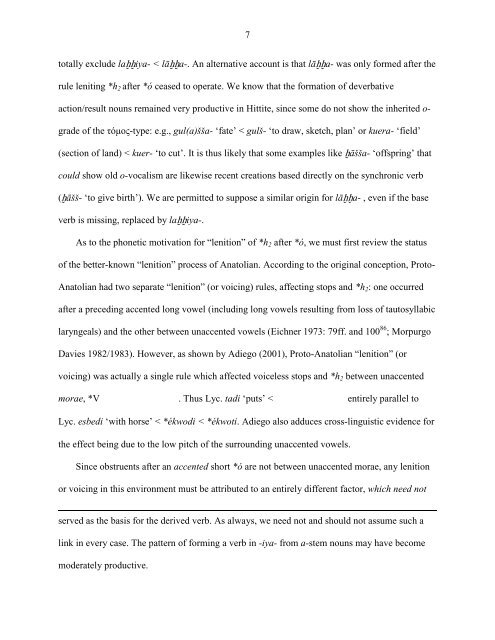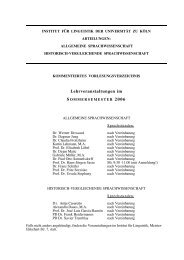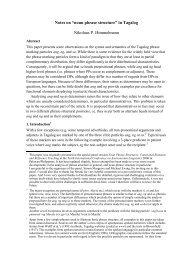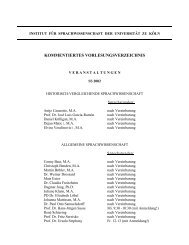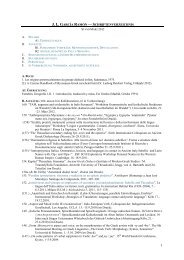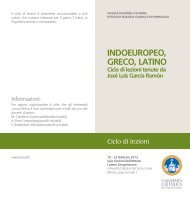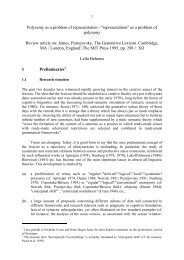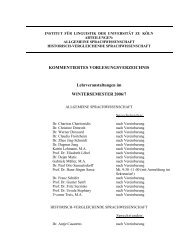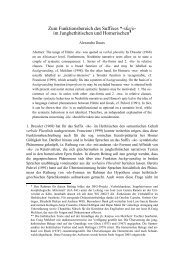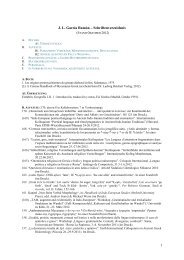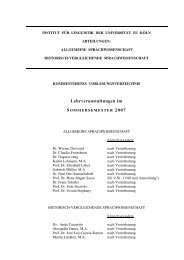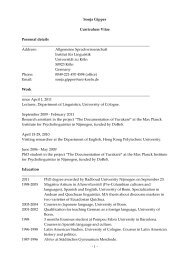Topics in Anatolian Historical Grammar Prof. Dr. H. Craig Melchert
Topics in Anatolian Historical Grammar Prof. Dr. H. Craig Melchert
Topics in Anatolian Historical Grammar Prof. Dr. H. Craig Melchert
You also want an ePaper? Increase the reach of your titles
YUMPU automatically turns print PDFs into web optimized ePapers that Google loves.
7<br />
totally exclude laḫḫiya- < lāḫḫa-. An alternative account is that lāḫḫa- was only formed after the<br />
rule lenit<strong>in</strong>g *h 2 after *ó ceased to operate. We know that the formation of deverbative<br />
action/result nouns rema<strong>in</strong>ed very productive <strong>in</strong> Hittite, s<strong>in</strong>ce some do not show the <strong>in</strong>herited o-<br />
grade of the τόμος-type: e.g., gul(a)šša- ‘fate’ < gulš- ‘to draw, sketch, plan’ or kuera- ‘field’<br />
(section of land) < kuer- ‘to cut’. It is thus likely that some examples like ḫāšša- ‘offspr<strong>in</strong>g’ that<br />
could show old o-vocalism are likewise recent creations based directly on the synchronic verb<br />
(ḫāšš- ‘to give birth’). We are permitted to suppose a similar orig<strong>in</strong> for lāḫḫa- , even if the base<br />
verb is miss<strong>in</strong>g, replaced by laḫḫiya-.<br />
As to the phonetic motivation for “lenition” of *h 2 after *ó, we must first review the status<br />
of the better-known “lenition” process of <strong>Anatolian</strong>. Accord<strong>in</strong>g to the orig<strong>in</strong>al conception, Proto-<br />
<strong>Anatolian</strong> had two separate “lenition” (or voic<strong>in</strong>g) rules, affect<strong>in</strong>g stops and *h 2 : one occurred<br />
after a preced<strong>in</strong>g accented long vowel (<strong>in</strong>clud<strong>in</strong>g long vowels result<strong>in</strong>g from loss of tautosyllabic<br />
laryngeals) and the other between unaccented vowels (Eichner 1973: 79ff. and 100 86 ; Morpurgo<br />
Davies 1982/1983). However, as shown by Adiego (2001), Proto-<strong>Anatolian</strong> “lenition” (or<br />
voic<strong>in</strong>g) was actually a s<strong>in</strong>gle rule which affected voiceless stops and *h 2 between unaccented<br />
morae, *V . Thus Lyc. tadi ‘puts’ < entirely parallel to<br />
Lyc. esbedi ‘with horse’ < *ékwodi < *ékwoti. Adiego also adduces cross-l<strong>in</strong>guistic evidence for<br />
the effect be<strong>in</strong>g due to the low pitch of the surround<strong>in</strong>g unaccented vowels.<br />
S<strong>in</strong>ce obstruents after an accented short *ó are not between unaccented morae, any lenition<br />
or voic<strong>in</strong>g <strong>in</strong> this environment must be attributed to an entirely different factor, which need not<br />
served as the basis for the derived verb. As always, we need not and should not assume such a<br />
l<strong>in</strong>k <strong>in</strong> every case. The pattern of form<strong>in</strong>g a verb <strong>in</strong> -iya- from a-stem nouns may have become<br />
moderately productive.


